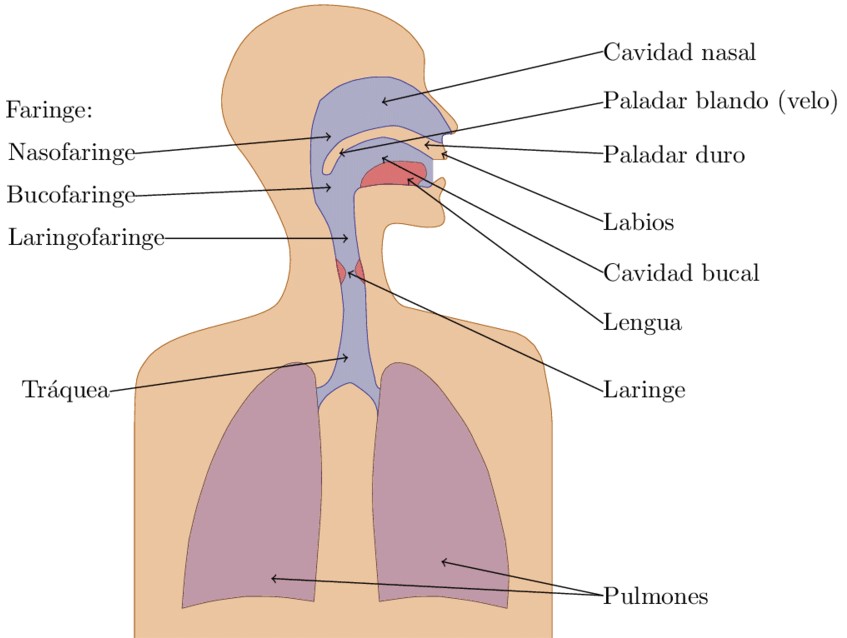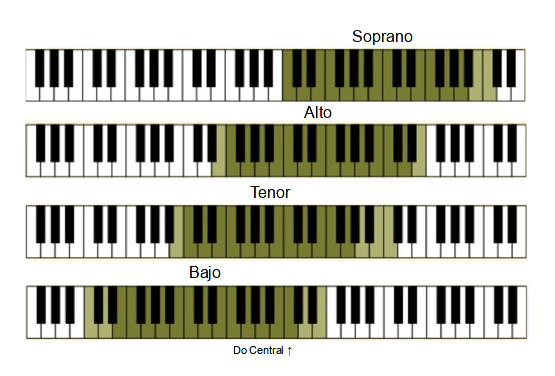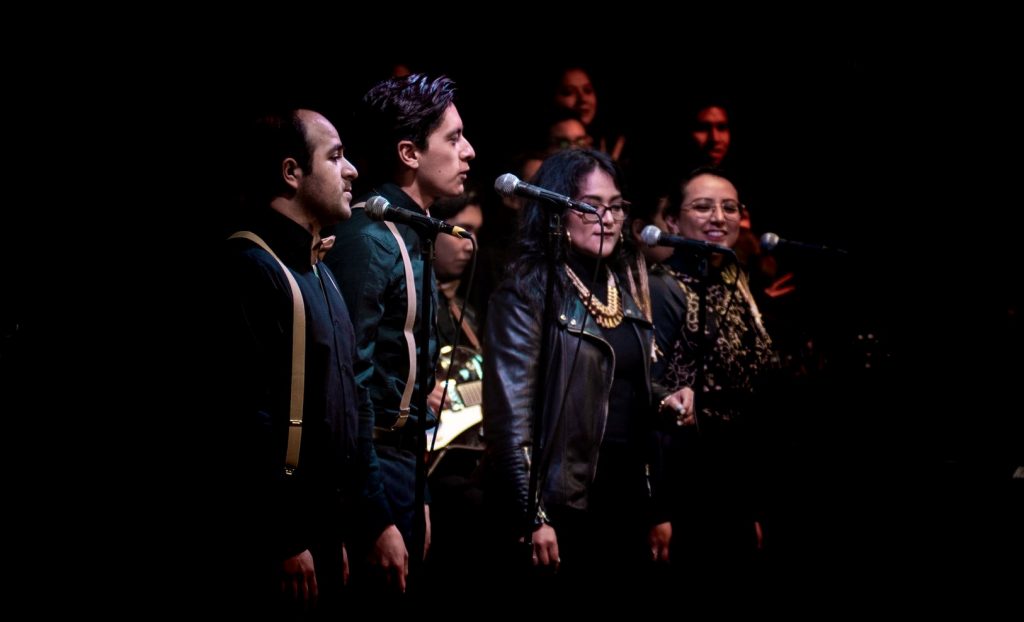The human voice is a wonderful instrument. It is capable of producing endless nuances, of providing an intense torrent of information on its own and, furthermore, its role in the musical context allows us to achieve extraordinary expressiveness and artistic emotion.

We are going to see how something as natural and everyday as carelessly singing a melody, the lyrics of a song or simply playing with it, explains many of the supposed mysteries that surround musical composition and songs in particular.
The voice, that instrument
The human voice, beyond its basic communicative and expressive role, is neither more nor less than our native musical instrument. What does this mean? Well, several things, but perhaps the most important of all is that it automatically turns us, if some pathology does not prevent it, into musicians by nature. Perhaps this seems like an exaggerated statement or outright absurd, but, before condemning this idea to the limbo of madness, let's see what the human voice is, what we can do with it and what we actually do with it on a daily basis.
Physiology
If we examine the physiology, the physical organs that make it possible for us to be able to emit these articulate, varied, meaningful sounds, we will see that the breathingthe vocal cords and the resonators Bodily bodies are directly responsible for that kind of miracle that we have won in the lottery of evolution. Without going in depth into how we sing, or how we sing how we sing, or how we should sing to sing how we would like to sing, etc… we will say that when we exhale air from our lungs the vocal cords in the larynx are capable of vibrating and producing a sound that is amplified by body resonators, which are basically interior cavities of our body, such as the palate, tongue or lips, for example.
 Speaking device
Speaking device
The vocal sound
This mechanism of breathing, phonation or creation of sound and articulators that make the voice resonate in one way or another, forms the particular timbre of each person, our characteristic voice. Therefore, we can say that the human voice is a full-fledged wind instrument that, combined with the significant power of language, gives it a completely extraordinary dimension. But even without taking into account that we can say things with our voice, the sonic and musical aspect of the human voice is incredibly rich and flexible in itself. It can imitate other instruments with amazing fidelity, it can be modulated and twisted a lot, and it can even generate quite radical and extreme sounds. Singing clearly illustrating a lament or a doubt or a moment of weakness or great joy, euphoria or despair, all this is possible by modulating the voice, without even saying anything in particular.
Main features
The three main characteristics of the human voice are pitch, volume, and timbre. He tone wave height It is what we commonly associate with notes. Sharper or lower, higher or lower, and everything related to tuning, in short. He volume either intensity or whatever you want to call it, it is the strength that we perceive from a spoken or sung voice, the presence or predominance, so to speak, of a vocal flow with respect to other sound sources. And finally, the ring. Each voice has its own sound, its own recognizable qualities, its personal seal that is the result of that journey through the interior of the human body before coming out through our mouths. From a purely sound point of view, the combination of the different presences of natural harmonics is what distinguishes the timbre of one voice from that of others.
The tessitura
A concept related to singing is tessitura. This word refers to the range that each human voice is capable of reproducing clearly and reliably. To the notes that we can sing with our bodily characteristics and our abilities in that process. Traditionally, human voices have been divided into four large groups. Among the female voices sopranos and the alto or alto. Among the men, the tenors and the bass.
 The basic vocal ranges But in the real and not theoretical world, a human voice can exceed those ranges or tessituras and cover more or fewer notes. For this reason, added ranges or extensions appeared in this theoretical field, such as baritones or mezzo-sopranos. A healthy and moderately controlled voice can cover a range of two octaves, although the exceptions and cases are innumerable. Each voice is different and, to really sing, the tessitura or amplitude of notes that we can produce is just one more factor in the act and art of singing.
The basic vocal ranges But in the real and not theoretical world, a human voice can exceed those ranges or tessituras and cover more or fewer notes. For this reason, added ranges or extensions appeared in this theoretical field, such as baritones or mezzo-sopranos. A healthy and moderately controlled voice can cover a range of two octaves, although the exceptions and cases are innumerable. Each voice is different and, to really sing, the tessitura or amplitude of notes that we can produce is just one more factor in the act and art of singing.
The voice and the music
Let's now talk a little about the special relationship that exists between the human voice and music. Sometimes, when we are immersed in the practice of our favorite or habitual musical instrument, for example, it is very easy to lose sight of the most basic characteristics of this art: melody and rhythm. These two pillars of music are, coincidentally, or not so coincidentally, elements that a single human voice can reproduce without any external help. Harmony, for example, singing a chord, can only be achieved with a successive arpeggiated form of singing or with complex vocal techniques. In any case, this gives an idea of the very close relationship of the human voice with any musical form. Composing singing, for example, is the most common thing in the world, the most logical, if you think about it, and probably the most effective. Just to mention a decisive element in the musical development of any work, we will talk about silence. Although it may seem somewhat contradictory, when we sing we need to inspire to interpret any melody or musical passage and that need is inevitably transferred to the logic and sense of including pauses, dividing the creative flow, leaving space to organize musical phrases and establishing a kind of dialogue. among them, to give some examples. Pauses, among other vocal characteristics, permeate all music from its conception and give it in some way that human, fragmentary, structured and rich touch, compared to other options that, although technically possible in some cases, directly clash with the way how we perceive things and express ourselves.
 Choir of singers
Choir of singers
The voice and the songs
And what to say about the songs? The voice is the distinctive element of these works and, in the same way as music or even more, it is conditioned by the physiological limits of the human speech apparatus. On the other hand, it benefits from its multiple qualities and options, both meaningful and purely sonic. We have all had the opportunity to listen to a song that we already know performed by a new voice that has made us rediscover it, possibly discover other surprising or simply sublime nuances that were not present in the previous or original version or were very different. The singing voice is a bottomless pit, it regularly gives us major surprises and we hear things that we had not even imagined possible. Therefore, the human voice applied to singing is something completely natural and, at the same time, something extraordinary, with an incredible range of possibilities that, honestly, is little exploited in musical reality, due to the human tendency to do things In the same way that they have been doing, to the fashions, genres or styles of each era or community, to seek success or recognition through the emulation of others and previous ones. From time to time, luckily, there are exceptions that confirm this rule and please our ears with something different. Singers like Leonard Cohen or Serge Gainsburg, reciters almost more than singers, Dolores O'Riordan, from The Cramberries, breaking her voice occasionally and giving extra expressiveness with it, Experimental and radical singers like Diamanda Gallas and many others, playful and very varied such as Liza Minelli or Jeff Buckley, etc… In Spanish, likewise, Enrique Bunbury with that characteristic emphasis, Serrat, Luis Alberto Spinetta, each with their characteristic way of singing, and some others have achieved a personal expressiveness in their interpretations, you like it more or less. Singing in modern popular music usually seeks naturalness and generally uses few devices or vocal experiments. In any case, knowing concepts of vocal technique such as imposition, projection and others can be useful to become aware of how we sing and, perhaps, how we could sing or enrich our particular form of vocal performance.
 use your voice
use your voice
Conclusions
Expression and communication, subjectivity and objectivity, emotion plus data, feelings and information, all these elements and more come together in the potential of singing. Singing is a pillar of music and songs, probably the main one. Even instrumental passages, the phrasing of many instruments and the logic of melodic developments draw directly from how we speak and sing, from what we can do and what we cannot, and end up being for most of us a foundation of understanding and meaning. that we perceive from the music we listen to. Singing is much more than singing, but the simple act of singing is already very important for communication, for living completely, and even for health. We have to sing in any of its forms. Singing alone and in company, expressing ourselves through this fantastic instrument that evolution has given us, singing to know ourselves and to be known better, singing in the shower, in the kitchen and on the street, singing to compose music and songs, sing to better play any musical instrument. Sing, listen, and above all, sing. I don't have better advice to give. #mailpoet_form_3 .mailpoet_form { } #mailpoet_form_3 .mailpoet_column_with_background { padding: 10px; } #mailpoet_form_3 .mailpoet_form_column:not(:first-child) { margin-left: 20px; } #mailpoet_form_3 .mailpoet_paragraph { line-height: 20px; margin-bottom: 20px; } #mailpoet_form_3 .mailpoet_segment_label, #mailpoet_form_3 .mailpoet_text_label, #mailpoet_form_3 .mailpoet_textarea_label, #mailpoet_form_3 .mailpoet_select_label, #mailpoet_form_3 .mailpoet_radio_label, #mailpoet_form_3 .mailpoet_checkbox_label, 3 .mailpoet_list_label, #mailpoet_form_3 .mailpoet_date_label { display: block; font-weight: normal; } #mailpoet_form_3 .mailpoet_text, #mailpoet_form_3 .mailpoet_textarea, #mailpoet_form_3 .mailpoet_select, #mailpoet_form_3 .mailpoet_date_month, #mailpoet_form_3 .mailpoet_date_day, #mailpoet_form_3 .mailpoet_date_year, #mailpoet_form_3 .mailpoet_date { display :block; } #mailpoet_form_3 .mailpoet_text, #mailpoet_form_3 .mailpoet_textarea { width: 200px; } #mailpoet_form_3 .mailpoet_checkbox { } #mailpoet_form_3 .mailpoet_submit { } #mailpoet_form_3 .mailpoet_divider { } #mailpoet_form_3 .mailpoet_message { } #mailpoet_form_3 .mailpoet_form_loading { width: 30px; text-align: center; line-height: normal; } #mailpoet_form_3 .mailpoet_form_loading > span { width: 5px; height: 5px; background-color: #5b5b5b; }#mailpoet_form_3{border: 1px solid #fcb900;border-radius: 40px;text-align: center;}#mailpoet_form_3 form.mailpoet_form {padding: 20px;}#mailpoet_form_3{width: 70%;}#mailpoet_form_3 .mailpoet_message {margin : 0; padding: 0 20px;}#mailpoet_form_3 .mailpoet_paragraph.last {margin-bottom: 0} @media (max-width: 500px) {#mailpoet_form_3 {background-image: none;}} @media (min-width: 500px) { #mailpoet_form_3 .last .mailpoet_paragraph:last-child {margin-bottom: 0}} @media (max-width: 500px) {#mailpoet_form_3 .mailpoet_form_column:last-child .mailpoet_paragraph:last-child {margin-bottom: 0}} Please leave this field emptyDo you write songs or would you like to?
Email * I have read and accept the Privacy Policy With the Guide «The journey of a song» as a gift Check your inbox or spam folder to confirm your subscription.

